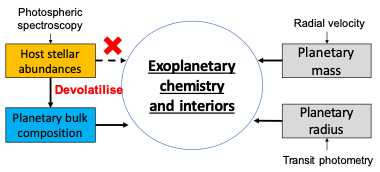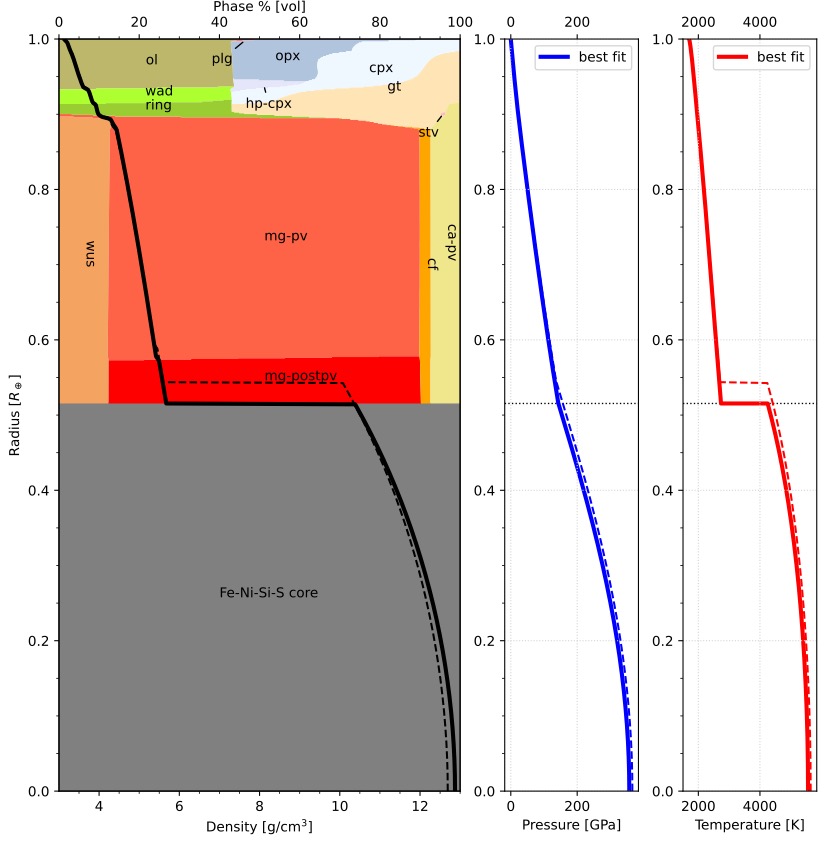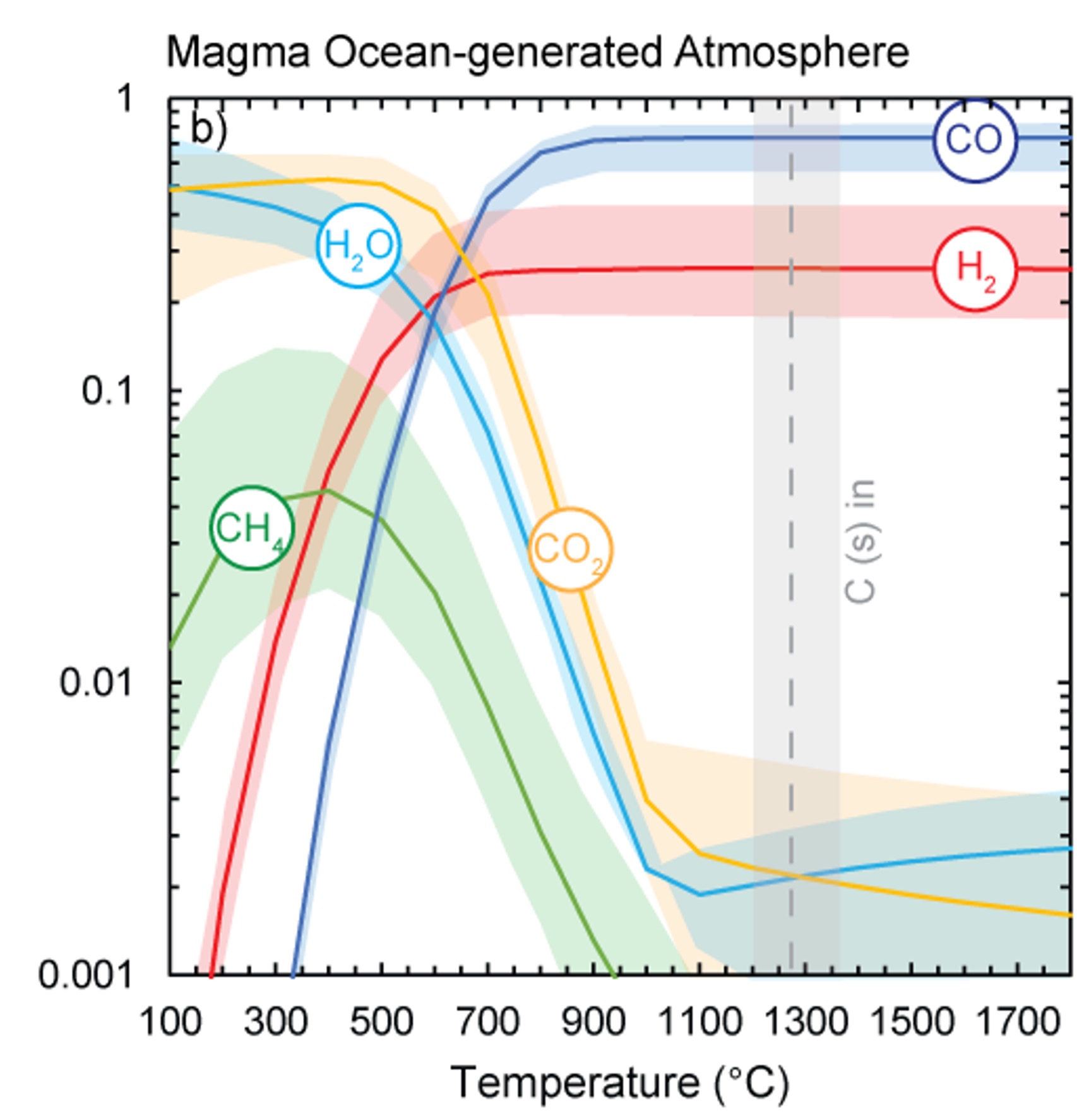Planetary Composition
Exoplanetary composition (except for the atmosphere) cannot be directly measured, but is the key to understanding the planetary interiors, long-term evolution, atmospheric formation, and ultimately habitability. Therefore, models established based on the observables of exoplanets (e.g. mass, radius, and orbits), host stars (e.g. luminosity and chemical composition), and protoplanetary discs (e.g. structure and composition) are indispensable for a better understanding of the nature of the increasingly discovered exoworlds, among which many are potentially terrestrial.
Along this line, we have been carrying out a number of research projects broadly in the field of comparative (exo)planetology, led by Dr. Haiyang Wang, who was affiliated with both the Exoplanets & Habitability group and the Experimental Planetology group (in the D-ERDW).

Nebular condensation
Condensation of solid materials out of stellar nebulae determines the primordial bulk composition of the planetary building blocks. Canonical condensation models are based on a nebular gas of Solar composition. However, the variability in metallicity and metal/oxygen ratios of extrasolar systems inferred from the spectroscopic measurements of their parent stars implies that the identity, abundance and sequence of condensation may deviate from that of our solar system. As such, planets formed even at similar heliocentric distances may be expected to have distinct compositions from those of our solar system terrestrial planets. Here at E&H (and in collaboration with ETH Earth Science colleagues), we are developing models that can deal with the versatile condensation processes adaptable to different planetary systems (e.g. Wang et al. 2020a, Wang & Sossi 2022).
Devolatilisation
To first order, Earth is a devolatilised piece of the solar nebula. Similarly, rocky exoplanets are almost certainly devolatilised pieces of the stellar nebulae out of which they and their host stars formed. If this premise holds, we can estimate the chemical composition of rocky exoplanets by measuring the elemental abundances of their host stars, and then applying a devolatilisation algorithm. Our pioneering devolatilisation approach was benchmarked with the proto-Sun and bulk Earth and other solar system rocky bodies (Wang et al. 2018, 2019a). And this model has been increasingly used in interpreting the chemical differences between stars and planets (Liu et al. 2020, Liu & Ni 2023, Spaagaren et al. 2023).
Interior modelling
The interior structure and mineralogy can inform us the in-depth nature of the increasingly discovered rocky worlds, enabling one to further understand the potential geological activities (including mantle convection, plate tectonics, and dynamos). Recent results have highlighted the importance to apply the above-mentioned devolatilisation to the bulk composition of planet-hosting stars, together with planetary mass and radius measurements, to constrain the interiors of terrestrial-type exoplanets (Fig.2; Wang et al. 2019b, 2022ab). The devolatilization and interior modelling package, named “ExoInt”, is publicly available on external page GitHub and listed in NASA-GSFC Exoplanet Modeling & Analysis Center (external page EMAC). A python version of the ExoInt package (“pyExoInt”) has also been developed and accessible external page here.

Evolution & habitability implications
Habitability is a measure of an environment’s potential to support life including its emergence and evolution (Meadows et al. 2009, Cockell et al. 2016). It is therefore important to understand exoplanet interior, surface, and atmosphere as well as their interactions over the geological timescale. At E&H, we combine perspectives from different fields such as astrochemistry, geochemistry, geophysics, as well as stellar and planetary astrophysics to understand exoplanetary evolution and habitability. One example is our comprehensive examination of the plausible geothermal and geodynamical evolution as well as early atmospheric species of a model Earth-sized planet in the habitable zone around -Cen A/B (“-Cen-Earth”, Fig.3; Wang et al. 2020b, 2022b). It lays the foundation for an in-depth characterisation of potentially terrestrial worlds in the solar neighbourhood, helping guide the future observations towards finding another “Pale Blue Dot(s)”.
Our research has been (partially) carried out under the framework of National Centre of Competence in Research PlanetS, which is supported by the Swiss National Science Foundation. Please also check recent news coverages of our research output:
- external page call_made Nature Astronomy: Deep down, not too different from Earth
- external page call_made Forbes: We’ve Got 13 Years To Find ‘Another Earth’ In The Closest Star System
- external page call_made New York Post: What a habitable alternative Earth would look like
- chevron_right ETH press release: Imagining an Earthly neighbour
- external page call_made NCCR PlanetS: Stars with planets show no special fingerprint
References
Cockell, C. S., Bush, T., Bryce, C., et al. 2016. Habitability: A Review. Astrobiology 16:1.
Liu, F., Yong, D., Asplund, A., Wang, H. S., Spina, L., Acuna, L., Melendez, J., Ramirez, I. 2020. Detailed chemical compositions of planet-hosting stars – I. Exploration of possible planet signatures. MNRAS 495: 3961-3973.
Liu, Z. and Ni D. 2023. Quantitative correlation of refractory elemental abundances between rocky exoplanets and their host stars. A&A 674:A137.
Meadows, V. S., Claire, M. W., Domagal-Goldman, S. D., et al. 2009. The Search for Habitable Environments and Life in the Universe. In: Astro2010: The Astronomy and Astrophysics Decadal Survey, Science White Papers, no. 201.
Sossi, P., Wang, H. 2022. The effect of stellar composition on nebular condensation. European Planetary Science Congress 2022, EPSC2022-188
Spaargaren, R. J., Wang, H. S., Mojzsis, S. J., Ballmer, M. D., Tackley, P. J. 2022. Plausible constraints on the range of bulk terrestrial exoplanet compositions in the Solar neighbourhood. ApJ 948:53.
Wang, H. S., Lineweaver, C.H., Ireland, T. R. 2018. The elemental abundances (with uncertainties) of the most Earth-like planet. Icarus 299:460-474.
Wang, H. S., Lineweaver, C. H., Ireland, T. R. 2019a. The volatility trend of protosolar and terrestrial elemental abundances. Icarus 328:287- 305.
Wang, H. S., Liu, F., Ireland, T. R., Brasser, R., Yong, D., Lineweaver, C. H. 2019b. Enhanced constraints on the interior composition and structure of terrestrial exoplanets. MNRAS 482:2222-2233.
Wang, H. S., Sossi, P. A., Quanz, S. P. 2020a. Nebular condensation of different stellar compositions and its influence on planetary chemistry. Europlanet Science Congress 2020, online, 21 September–9 Oct 2020, EPSC2020-874.
Wang, H. S., Morel, T., Quanz S. P., Mojzsis, S. J. 2020b. Europium as a lodestar: diagnosis of radiogenic heat production in terrestrial exoplanets [Spectroscopic determination of Eu abundances in α Centauri AB]. A&A 644:A19.
Wang, H. S., Quanz, S. P., Yong, D., Liu, F., Seidler, F., Acuna, L., Mojzsis, S.J. 2022a. Detailed chemical compositions of planet hosting stars: II. Exploration of the interiors of terrestrial-type exoplanets. MNRAS 513:5829-5846.
Wang, H. S., Linweaver, C. H., Quanz, S. P., Mojzsis, S. J., Ireland, T. R., Sossi, P. A., Seidler, F., and Morel, T. 2022b. A model Earth-sized planet in the habitable zone of α Centauri A/B. ApJ 927:134.
